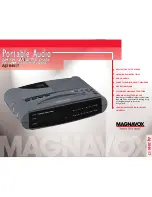
The SAF FreeMile Series Full Outdoor Unit Technical Description and Configuration Guide • Rev. 1.3
© SAF Tehnika JSC 2012
70
1.
Shows
time
period
during
which
statistics
have
been
gathered;
2.
Modem
state
–
shows
if
the
modem
is
operating
correctly;
3.
Clear
statistics
–
resets
all
statistics
counters
(not
available
for
“guest”
account);
4.
Truncated
frames
–
number
of
truncated
received
frames;
5.
Long
events
–
frames
having
byte
count
greater
than
MAXIMUM
FRAME
SIZE
parameter
(1518,
1536
or
1916
bytes);
6.
Vlan
tags
detected
–
VLAN
tagged
frames;
7.
Unsup.
opcodes
–
frames
recognized
as
control
frames
but
contained
an
Unknown
Opcode;
8.
Pause
frames
–
frames
received
are
control
frames
with
valid
PAUSE
opcodes;
9.
Control
frames
–
frames
received
as
control
frames;
10.
Dribble
nibbles
–
indicates
that
following
the
end
of
the
packet
additional
1
to
7
bits
are
received.
A
single
nibble,
named
the
dribble
nibble,
is
formed
but
not
sent
to
the
system;
11.
Broadcasts
–
packets,
which
destination
address
contained
broadcast
address;
12.
Multicasts
–
packets,
which
destination
address
contained
multicast
address;
13.
Dones
–
reception
of
packets
successfully
completed;
14.
Jumbo
frames
–
frame
Type/Length
field
larger
than
1518
(Type
Field)
bytes;
15.
Length
check
errors
–
frame
length
field
in
the
packet
does
not
match
the
actual
data
byte
length
and
is
not
a
Type
Field;
16.
CRC
errors
–
frame
CRC
do
not
match
the
internally
generated
CRC;
17.
Code
errors
–
one
or
more
nibbles
are
signalled
as
errors
during
reception
of
the
packet;
18.
False
carrier
errors
–
indicates
that
following
the
last
received
statistics
vector,
a
false
carrier
was
detected,
noted
and
reported
with
next
received
statistics.
The
false
carrier
is
not
associated
with
this
packet.
False
carrier
is
activated
on
the
receiving
channel
that
does
not
result
in
a
packet
receive
attempt
being
made;
19.
Rx
Dv
event
–
indicates
that
the
last
receiving
event
seen
is
too
short
to
be
a
valid
packet;
20.
Prev.
pkt
dropped
–
indicates
that
since
the
last
RSV,
a
packet
is
dropped
(i.e.
interframe
gap
too
small);
21.
Byte
counter
–
total
number
of
bytes
received
on
the
wire,
not
counting
collided
bytes;
22.
FCS
errors
–
number
of
generic
framing
procedure
(GFP)
frames
with
CRC
errors
received
by
the
de
‐
encapsulation
block;
23.
CHEC
errors
–
number
of
generic
framing
procedure
(GFP)
frames
with
CHEC
errors
received
by
the
de
‐
encapsulation
block;
24.
Dropped
frames
–
number
of
generic
framing
procedure
(GFP)
frames
that
were
dropped
in
the
de
‐
encapsulation
block;
25.
Delineation
errors
–
number
of
‘lost
of
synchronization’
events;
26.
Vlan
tags
–
number
of
VLAN
tagged
packets,
32
‐
bit
counter;
27.
Backpres.
events
–
carrier
‐
sense
‐
method
backpressure
was
previously
applied;
28.
Pause
frames
–
frames
transmitted
are
control
frames
with
a
valid
PAUSE
opcodes;
29.
Control
frames
–
frames
transmitted
are
control
frames;
30.
Wire
byte
counter
–
total
number
of
bytes
transmitted
on
the
wire,
including
all
bytes
from
collided
attempts;
31.
Underruns
–
underruns
occur
during
frame
transmission;
32.
Giants
–
frames
having
byte
count
greater
than
the
MAXIMUM
FRAME
SIZE
parameter
(1516,
1536
or
1916
bytes);
33.
Late
collisions
–
Collisions
occurred
beyond
the
collision
window
(512
bit
times);
34.
Max
collisions
–
packets
aborted
after
number
of
collisions
exceeded
the
RETRANSMISSION
MAXIMUM
parameter;
35.
Excessive
defers
–
packets
deferred
in
excess
of
6,071
nibble
times
in
100
Mbps
mode,
or
24,287
bit
‐
times
in
10
Mbps
mode;
Содержание FreeMile Series
Страница 1: ...1 Technical Description and User Guide ...















































